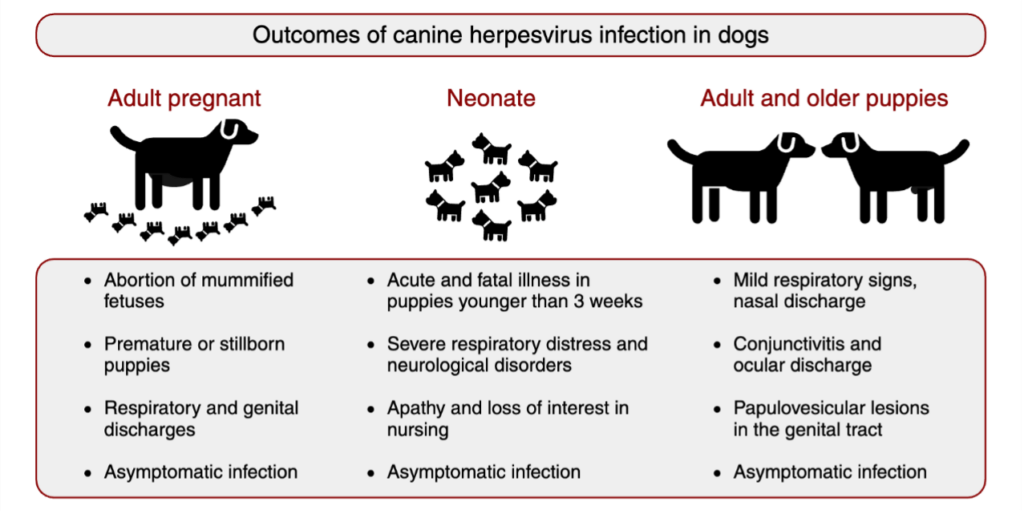The threat of canine herpesvirus to pregnant bitches and neonate puppies
Mathias Martins, D.V.M, M.Sc., Ph.D.
Canine herpesvirus (CHV), or Varicellovirus canidalpha1, belongs to the subfamily Alphaherpesvirinae within the Herpesviridae family. This significant pathogen affects domestic dogs, notably neonates, and is likely to be globally distributed with varying prevalence across different geographic regions. While there is a need for more recent data on the seroprevalence of CHV in the United States, historical records indicate that less than 10% of randomly selected dog populations were positive. Nevertheless, the prevalence can be as high as 100% in shelters and kennel settings with high-density dog housing.
The pathogenesis of CHV involves a complex interplay between viral factors and host immune responses. The virus primarily targets the respiratory and genital mucosa, progressing to infection, replication, and often leading to clinical manifestations. A remarkable characteristic of CHV is its capacity for establishing latency, primarily in sensory ganglia, such as the trigeminal ganglia, following the initial infection. During this asymptomatic period, the virus remains dormant, with the infected dog showing no clinical signs of illness. Viral reactivation from latency can occur, triggered by stressors like parturition or animal transportation, immunocompromising disease, or immunosuppressive therapy. It may lead to viral shedding in secretions from the genital and respiratory tracts. The asymptomatic nature of latency may pose diagnostic challenges. Despite these, understanding the characteristics of CHV latency is crucial for managing the disease, as it plays a central role in maintaining the virus within canine populations.
The clinical manifestations of CHV infection range from mild to severe, depending on the animal’s age. This virus predominantly impacts puppies, particularly those under three weeks of age, often resulting in elevated mortality rates within the affected litter. Infected puppies may manifest systemic infection, presenting intense respiratory distress and neurological disorders, ultimately leading to sudden death. Pathological observations on deceased puppies include multifocal areas of necrosis and hemorrhagic regions in most organs, including lung, liver, brain, and intestine, with the kidney being the classically affected organ. In addition, the presence of enlarged lymph nodes and spleen can be noted. While nonpregnant adult animals often present mild respiratory symptoms and conjunctivitis, pregnant bitches may undergo reproductive failure, manifested as abortion, stillbirths, or the birth of weak and nonviable puppies. A summary of the potential consequences of CHV infection in dogs categorized by age is shown in Figure 1.

Figure 1. Summary of canine herpesvirus (CHV) infection outcomes in dogs categorized by age. In this schema, puppies aged three weeks or more are classified as older.
Accurate and timely diagnosis of CHV infection is essential for effective disease management. The diagnostic process should utilize multifaceted approaches. Detecting antibodies in serum through virus neutralization assay provides insight into the immune response post-exposure and serves as a tool to identify carrier animals. Moreover, active infections can be assessed through virus isolation and PCR assays performed on nasal, ocular, and genital secretions, as well as on tissues from aborted fetuses or deceased puppies. Importantly, necropsy and histopathological evaluation can provide valuable insights.
Preventive measures for CHV require an interdisciplinary effort. With no vaccine currently available for CHV in the United States, it is critical to mitigate viral transmission by protecting pregnant bitches and vulnerable puppies. Identifying positive dams and prospectively optimizing environmental conditions to reduce stress in known carrier animals is essential. Additionally, providing supportive care for affected puppies remains indispensable. In this sense, veterinarians play a pivotal role in understanding and addressing the challenges posed by CHV in the canine population. Their expertise, along with the utilization of diagnostic tools, facilitates the establishment of effective strategies for disease management. Periodic serological monitoring and the identification of carriers allow for timely intervention to reduce losses, particularly in breeding dogs. During outbreaks and in kennels affected by CHV, implementing strict biosecurity measures and customizing management plans is imperative. This approach mitigates the risk of the virus spreading to other dogs and safeguards the overall health and reproductive success of canine populations.
In summary, CHV is a significant pathogen for the canine breeding community due to its impact on reproductive failure and neonatal mortality. Although CHV might be considered a minor threat to healthy and immunocompetent animals, it can have significant consequences for pregnant bitches and young puppies. The importance of utilizing diagnostic tools to accurately confirm CHV infections cannot be overstated, as timely and precise identification is fundamental for target interventions and reducing the impact on breeding programs. Ongoing and future research on CHV epidemiology, pathogenesis, vaccine development, and therapeutic interventions is crucial for discovering and establishing effective disease control and prevention measures.
References
Decaro N, Martella V, Buonavoglia C. Canine adenoviruses and herpesvirus. Vet Clin North Am Small Anim Pract. 2008. doi: 10.1016/j.cvsm.2008.02.006.
Evermann JF, Ledbetter EC, Maes RK. Canine reproductive, respiratory, and ocular diseases due to canine herpesvirus. Vet Clin North Am Small Anim Pract. 2011. doi: 10.1016/j.cvsm.2011.08.007
Greene CE. Canine Herpesvirus Infection. In: Greene CE (Ed.). Infectious diseases of the dog and cat. 4th edition. WB Saunders, Philadelphia. 2012. pp. 48–54